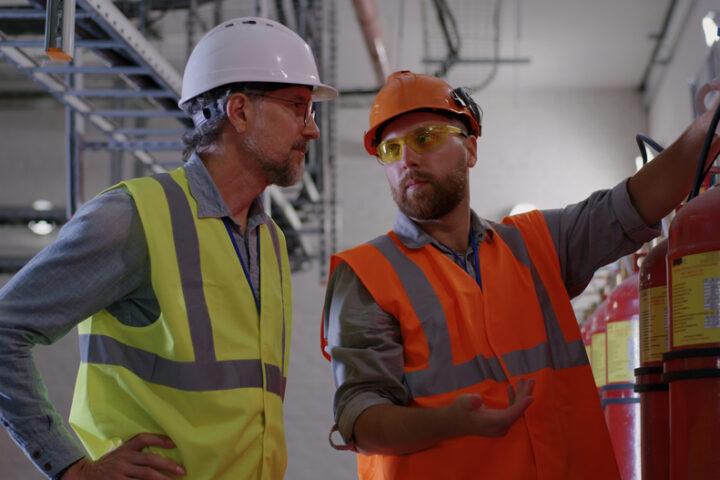A strong health and safety culture is essential for any organisation, contributing to employee well-being, regulatory compliance, and operational efficiency. While written policies and procedures are crucial, fostering a culture of safety requires more than just rules on paper. It involves creating an environment where everyone from senior leaders to new hires prioritises health and safety in their daily actions and decisions.
In this blog, we’ll explore practical steps and resources for building a robust health and safety culture, and how organisations can create a workplace where safety is embedded into every level of operation.
1. The Importance of a Health and Safety Culture
A health and safety culture goes beyond compliance with regulations. It involves a collective commitment to protecting everyone’s well-being and fostering a sense of shared responsibility across the workforce. Organisations with a strong safety culture experience:
- Lower incident rates: A proactive approach to safety helps prevent accidents, reducing downtime, injury costs, and productivity losses.
- Improved employee morale: Employees feel valued and secure when they know their well-being is a priority, leading to higher engagement and job satisfaction.
- Better compliance with regulations: A culture that emphasises health and safety ensures that teams adhere to legal requirements, reducing the risk of fines and legal challenges.
- Enhanced reputation and trust: A commitment to safety demonstrates a company’s responsibility towards employees and the community, boosting its image and credibility.
Building a culture where health and safety are prioritised not only protects employees but also creates a resilient, productive, and successful organisation.
2. Start with Leadership Commitment
Leadership is at the heart of establishing a strong health and safety culture. When senior leaders demonstrate a commitment to health and safety, employees are more likely to follow suit. Leaders set the tone, and their actions send a powerful message about the importance of safety.
Key actions for leaders include:
- Incorporating safety into business objectives: Demonstrate that health and safety are integral to the company’s mission, linking them to overall business goals.
- Participating in safety training and meetings: When leaders engage in safety training alongside their teams, it signals a unified commitment to a safe work environment.
- Regularly communicating safety as a priority: Leaders should frequently communicate the importance of health and safety, whether in team meetings, newsletters, or company-wide emails.
Visible commitment from leadership fosters trust and inspires employees to adopt the same commitment to safety, embedding it as a core organisational value.
3. Empower Employees with Knowledge and Training
Training is crucial in building a health and safety culture. Empowering employees with the knowledge and skills they need to perform tasks safely ensures they can identify hazards, respond appropriately to emergencies, and understand how to protect themselves and their colleagues.
Effective training should include:
- Induction training for new hires: Ensure that every new employee understands health and safety policies, emergency procedures, and expectations from day one.
- Role-specific training: Tailor training to the specific risks and requirements of each role, particularly for high-risk tasks like operating machinery or handling hazardous substances.
- Refresher training: Regularly update employees on health and safety practices, reinforcing best practices and addressing any new risks or procedures.
By making training a continuous process rather than a one-time event, organisations reinforce the importance of safety, keeping knowledge fresh and reducing the likelihood of incidents.
4. Provide Access to Relevant Health and Safety Content
Having easy access to reliable health and safety information and resources is key to building a proactive safety culture. Employees should be able to access resources that help them understand and apply best practices, identify hazards, and stay informed on regulatory updates.
Offering a variety of health and safety content, such as guides, checklists, and training modules, helps reinforce safe practices across the workplace. By providing practical, up-to-date resources, organisations empower employees to take ownership of their safety and stay informed about relevant standards.
Centralising resources through a company intranet, digital library, or employee portal makes it easier for employees to access health and safety content at any time, ensuring they have the information needed to work safely.
5. Foster Open Communication and Reporting
A strong safety culture relies on open communication, where employees feel comfortable reporting hazards, near-misses, or unsafe behaviours without fear of reprisal. Creating a non-punitive reporting environment encourages employees to speak up, helping to prevent accidents and identify areas for improvement.
Encourage open communication by:
- Establishing anonymous reporting channels: Anonymous reporting systems allow employees to share concerns or report incidents without fear of judgement or repercussions.
- Encouraging feedback on safety practices: Involve employees in safety discussions and decision-making processes, and ask for feedback on what’s working and where improvements could be made.
- Holding regular safety meetings: Organise meetings where employees can discuss health and safety issues, share ideas, and offer solutions to common challenges.
Open communication and transparency create a more engaged workforce where employees feel empowered to take part in maintaining a safe environment.
6. Recognise and Reward Safe Behaviour
Recognising and rewarding safe behaviours reinforces the importance of health and safety while motivating employees to maintain high standards. When employees see that safety is valued and rewarded, they are more likely to prioritise safe practices in their own work.
Ways to recognise and reward safe behaviour include:
- Public acknowledgment: Highlight safe practices and achievements during team meetings, newsletters, or company-wide communications.
- Safety incentive programmes: Offer small rewards or incentives for consistent adherence to safety protocols, reporting hazards, or completing safety training.
- Employee of the Month awards: Recognise employees who demonstrate exemplary commitment to safety with awards, fostering a sense of pride in maintaining a safe work environment.
By celebrating safety, organisations make it clear that health and well-being are top priorities, reinforcing positive behaviours and encouraging employees to take ownership of safety.
7. Conduct Regular Safety Audits and Inspections
Regular safety audits and inspections are vital for evaluating the effectiveness of health and safety practices, identifying potential risks, and ensuring compliance. Audits should be seen as a proactive measure to continuously improve safety rather than merely a compliance check.
To conduct effective audits:
- Review policies and procedures: Ensure that health and safety policies are up-to-date, align with current regulations, and address any new risks in the workplace.
- Inspect equipment and workspaces: Check that all equipment is in good working condition, safety measures are in place, and any hazards are identified and mitigated.
- Analyse incident reports and trends: Use incident data to identify recurring issues or high-risk areas, and address these in your safety plans.
Conducting regular audits and inspections not only ensures compliance but also demonstrates to employees that the organisation is committed to maintaining a safe environment.
8. Encourage Continuous Improvement and Adaptation
Health and safety is not a static goal but a continuous process of improvement. Organisations should regularly review and update health and safety practices, policies, and training to ensure they remain relevant and effective.
Ways to promote continuous improvement include:
- Evaluating incident reports: Analyse the causes of any incidents, near-misses, or injuries and make adjustments to prevent similar events in the future.
- Setting safety goals: Establish clear, measurable goals for health and safety performance, and monitor progress over time.
- Seeking employee input: Regularly gather feedback from employees on what’s working well and what could be improved in your safety approach.
By fostering a culture of continuous improvement, organisations ensure that health and safety practices evolve alongside new challenges, technologies, and best practices.
Conclusion
Building a strong health and safety culture requires more than just compliance with regulations; it involves creating an environment where every employee is committed to safeguarding their own well-being and that of their colleagues. From leadership commitment and employee training to access to relevant resources and open communication, a holistic approach to safety makes a positive impact on employee morale, productivity, and operational success.
Providing reliable health and safety content and ensuring everyone has the knowledge and resources to make informed safety decisions are essential steps towards a proactive and supportive safety culture. By making health and safety a core part of your organisation’s values, you create a workplace where everyone works together to protect each other, fostering a resilient and responsible environment that benefits both employees and the business as a whole.







